A Short Timetable History
CommentsJune 7, 2016
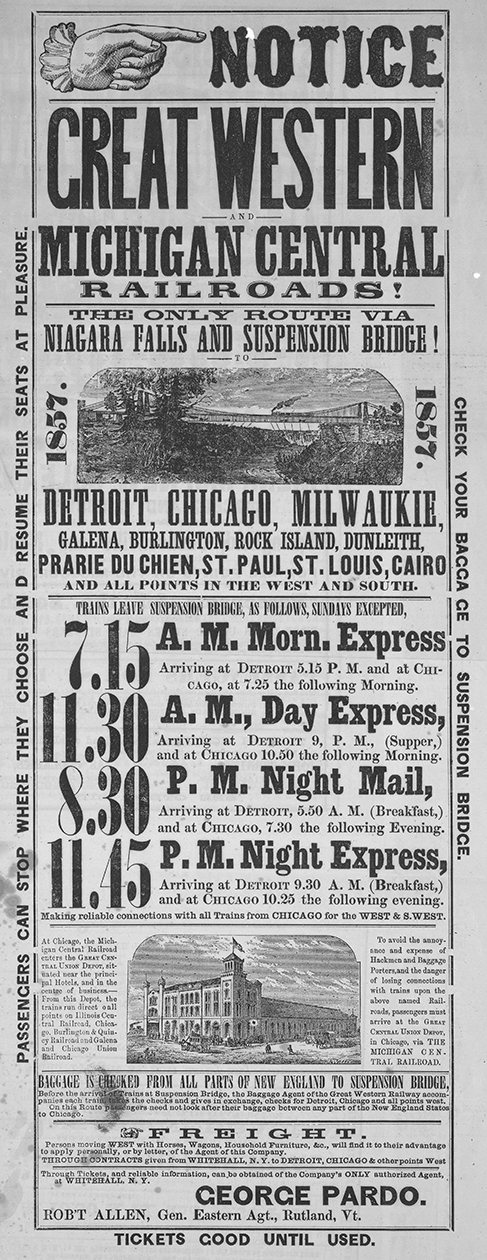
Great Western and Michigan Central railroads adver-
tisement, 1857. Courtesy of the Library of Congress.Time and its accuracy are paramount to railroading, which involves careful coordination of train movements. The importance of accurate timekeeping has long been reinforced by the prominent placement of clocks in depots large and small, as well as the distribution of timetables that help travelers plan their trips. Timetables today – whether paper or digital - still provide the exact hour and minute a train is scheduled to arrive at each station along a route.
In 1883, American and Canadian railroads jointly established four standardized continental time zones that eliminated the need to adhere to local time, which varied from one town to another based on when the sun was at its highest point in the sky (noon). Standardized time allowed for more efficient scheduling as the rail network expanded. By 1880 - approximately 50 years since the first American railroads had gone into operation - more than 93,000 miles of track had been laid; that number doubled by the dawn of the 20th century.1
According to timetable historians Dick Clover and Tom Coval, the first timetables printed between the 1830s and the Civil War “took the form of newspaper advertisements and posters, known as ‘broadsides’…The very first was placed by the Baltimore & Ohio Rail Road on May 20, 1830, in the Baltimore Patriot…”2 During the height of the Industrial Revolution that followed the Civil War, mechanized printing advanced so that multiple colors could be used to convey more complex information, especially in maps. Decorative embellishments such as illustrations of trains, cities and natural sights became common too.3
The merging of various small railroads into integrated networks such as the Pennsylvania, New York Central and Plant System meant that what had been one- or two- sheet timetables necessarily grew into multipage booklets. Development of the mechanical stapler bolstered this trend, allowing for inexpensive binding. By the start of the 20th century, timetables had become standardized folded booklets measuring 4” wide and 9” long that were easy to mail or place in display racks.4
Many railroads adopted standardized fonts and artwork that gave their timetables a consistent appearance. This followed on concurrent efforts to adopt unified equipment color schemes, standard employee uniforms and a particular architectural vocabulary for depots.
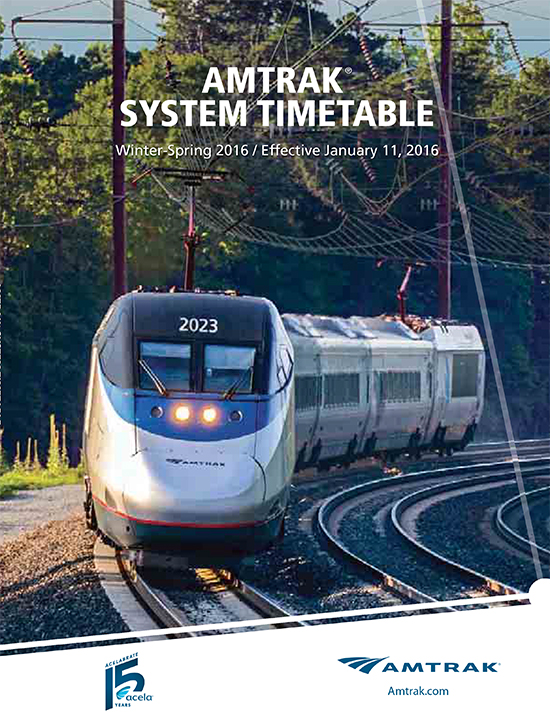
The Winter-Spring 2016 Amtrak national timetable
highlighted the 15th anniversary of Acela Express.
Since it began operations on May 1, 1971, Amtrak has followed in the footsteps of its predecessors, and throughout most of its history published national system timetables issued to coincide with seasonal time changes or major schedule adjustments. In the mid-1990s, Amtrak switched from a folded booklet to a magazine format. For many years, it published a separate Northeast services timetable and still produces individual folded paper brochures for all routes or groups of related routes. Over the last decade, the national system timetable generally consisted of more than 100 pages and included schedules for all Amtrak trains and Thruway buses; facts about local stations; guidance to booking a trip; national and regional maps; train equipment diagrams; and related information and policies.
In spring 2016, Amtrak announced that the Winter-Spring 2016 national system timetable would be the last printed version published and distributed. Focusing on a digital timetable is an environmentally friendly approach and enhances the company’s ability to provide better customer service by quickly updating schedules, policies and amenities information as needed rather than waiting until the next printing.
Due to changes in how customers seek information about our services – generally through Amtrak.com and Amtrak mobile apps – the demand for a printed timetable has steadily fallen since 2010. Although the paper version will no longer be available, customers may download a PDF of the national system timetable on Amtrak.com. The entire document or portions can easily be printed out at home or the office if needed.
To mark this transition, we take a look back at some of our favorite national system timetable covers, whose artwork and other details reveal information about the company in specific periods.
May 1, 1971
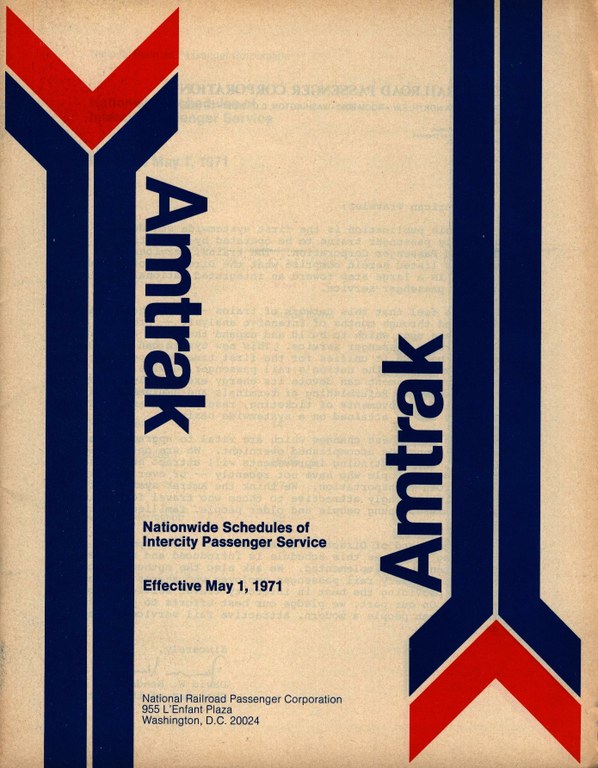 The first national system timetable prominently features the Amtrak name and service mark. Although officially known as the National Railroad Passenger Corporation, the company chose “Amtrak” as its common-use brand name. Developed by design firm Lippincott & Margulies, it is a blend of the words "American" and "track”… “a short, powerful name, easy to pronounce and remember, with high visual impact..." To complement the name, a motion-oriented service mark, known as the “motion mark,” was designed with modern graphics featuring the national colors of red, white and blue. The original mark was used from 1971 until 2000 when the current logo came into use.
The first national system timetable prominently features the Amtrak name and service mark. Although officially known as the National Railroad Passenger Corporation, the company chose “Amtrak” as its common-use brand name. Developed by design firm Lippincott & Margulies, it is a blend of the words "American" and "track”… “a short, powerful name, easy to pronounce and remember, with high visual impact..." To complement the name, a motion-oriented service mark, known as the “motion mark,” was designed with modern graphics featuring the national colors of red, white and blue. The original mark was used from 1971 until 2000 when the current logo came into use.
The timetable includes a letter from David Kendall, chairman of the Amtrak Board of Directors, in which he writes: “This new system can and will succeed because it unifies for the first time the operation and promotion of the nation’s rail passenger service…We are optimistic …that continuing improvements will attract hundreds of thousands of people…On our part, we pledge our best efforts to providing the American people with a modern, attractive rail service as rapidly as possible.”
According to an article about Amtrak timetables in the May 1973 edition of The Timetable Collector, the newsletter of the National Association of Timetable Collectors, only 50,000 copies of this first national system timetable were printed. “This hastily-prepared issue was printed by the publishers of The Official Guide…an unusual feature…is the inclusion of schedules for Amtrak service on the [Denver and] Rio Grande [Western Railroad] and the Southern [Railway], both of which eventually decided against joining Amtrak.”5
May 15, 1975
 Celebrating the arrival of the new E-60 locomotives, this national timetable featured an image by noted railroad artist Gil Reid. Against a vivid blue sky, E-60 locomotive No. 965 (on the right) passes the Metropark, N.J., station as a Metroliner Service train glides to a stop - a vision of modern railroading in the Northeast.
Celebrating the arrival of the new E-60 locomotives, this national timetable featured an image by noted railroad artist Gil Reid. Against a vivid blue sky, E-60 locomotive No. 965 (on the right) passes the Metropark, N.J., station as a Metroliner Service train glides to a stop - a vision of modern railroading in the Northeast.
The E-60, manufactured by General Electric and based on existing freight locomotives, was meant to replace the reliable but aging GG-1, which had first entered service on the Pennsylvania Railroad (PRR) in the 1930s. Weighing in at 193.5 tons, the E-60 could achieve approximately 6000 horsepower and was intended to reach speeds up to 120 mph. But the E-60 would prove too heavy, placing great stress on the rails when operating at high speeds. It was therefore limited to 90 mph, and Amtrak searched for a more practical unit, eventually settling on what became the AEM-7.
The Metroliners were high-speed Budd electric cars designed for use on the PRR's busy mainline between New York and Washington. The cars generally operated as married pairs, meaning that trains had an even number of cars. Luxurious interiors and fast running times made the Metroliners a viable competitor to the air shuttle. Under Amtrak, Metroliner Service frequencies increased to keep up with demand, and trains often reached speeds of up to 110 mph.
February 15, 1976
 This cover’s bright colors and rich blue background draw the eye, and it provides a little lesson on the evolution of American rail car design. Starting with what’s basically a carriage on wheels in 1830, the timeline ends with a shining new Amfleet car.
This cover’s bright colors and rich blue background draw the eye, and it provides a little lesson on the evolution of American rail car design. Starting with what’s basically a carriage on wheels in 1830, the timeline ends with a shining new Amfleet car.
Manufactured by the Budd Company, the Amfleet cars were based on the design of the popular Metroliner cars and were intended to replace older equipment purchased from the predecessor railroads. Covered in ridged stainless steel, the cars can be pulled at a top speed of 125 mph. The Amfleet cars originally came in five configurations: short- and long-distance coaches and cafe, dinette and club cars – the cover shows club car the Murray Hill. Early advertisements touted the cars’ “dual temperature control system…plush carpeting…and wider, more comfortable reclining seats to relax in.”
The first of the new single-level Amfleet cars went into revenue service on August 7, 1975. Four days earlier, Amtrak officials and invited guests took the cars on a maiden run between Washington and Philadelphia. The Amtrak Archives includes a souvenir commemorative ticket from that special run.
Many of the Amfleet cars were refurbished in the late 1990s and early 2000s at the Beech Grove, Ind., Heavy Maintenance Facility, and nearly 600 remain in use today, primarily on trains run east of the Mississippi River.
May 15, 1988
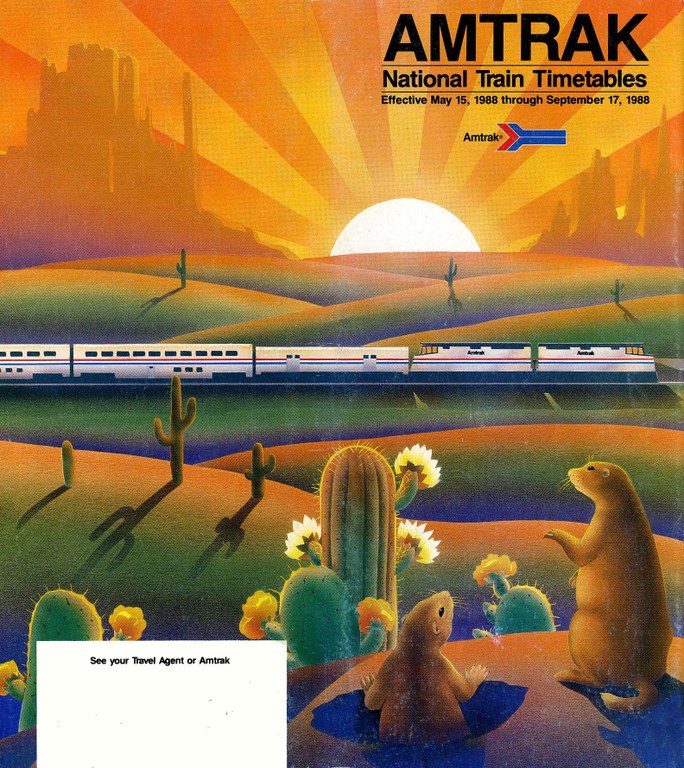 In the late 1980s and early 1990s, the national system timetables featured a series of stylized and imaginative travel-themed graphics by illustrator Nathan Davies, which were also used on postcards and posters. Based on the desert landscape depicted, complete with towering rock formations, flowering cacti and what might be a desert pocket gopher, the train shown is probably meant as a general representation of the Sunset Limited (New Orleans-San Antonio-Los Angeles), Southwest Chief (Chicago-Albuquerque-Los Angeles) or California Zephyr (Chicago-Denver-Emeryville), all of which offer travelers breathtaking views of desert landscapes.
In the late 1980s and early 1990s, the national system timetables featured a series of stylized and imaginative travel-themed graphics by illustrator Nathan Davies, which were also used on postcards and posters. Based on the desert landscape depicted, complete with towering rock formations, flowering cacti and what might be a desert pocket gopher, the train shown is probably meant as a general representation of the Sunset Limited (New Orleans-San Antonio-Los Angeles), Southwest Chief (Chicago-Albuquerque-Los Angeles) or California Zephyr (Chicago-Denver-Emeryville), all of which offer travelers breathtaking views of desert landscapes.
October 25, 1998
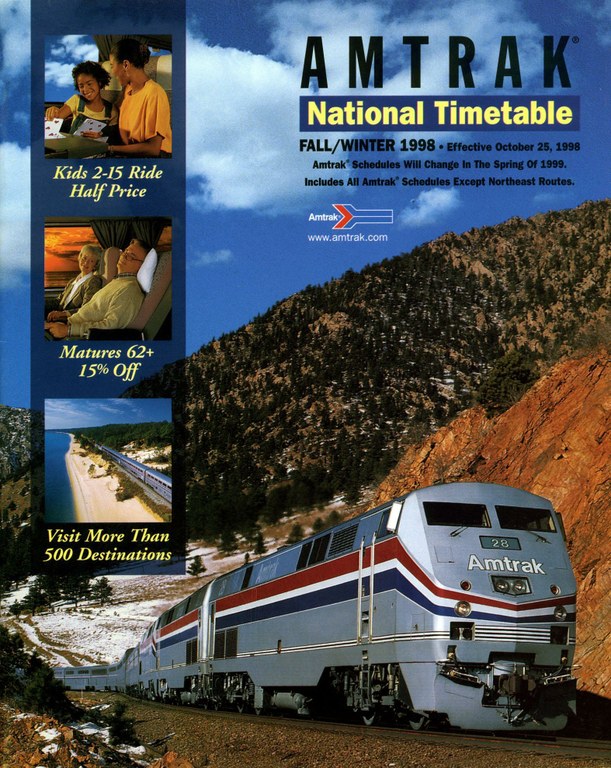 What makes this timetable cover significant is not so much the beautiful picture of a train passing through a mountainous landscape, but probably something you don’t notice at first. In the upper center is the Amtrak service mark with “www.amtrak.com” below. This is the first national timetable cover to advertise the company website, which launched in 1995 and ushered Amtrak into the Internet era. Upgrades made two years later let customers book travel directly through the website. At the time, according to World Bank data, nearly 22 percent of the American population had access to the Internet (that rose to about 87 percent by 2014).
What makes this timetable cover significant is not so much the beautiful picture of a train passing through a mountainous landscape, but probably something you don’t notice at first. In the upper center is the Amtrak service mark with “www.amtrak.com” below. This is the first national timetable cover to advertise the company website, which launched in 1995 and ushered Amtrak into the Internet era. Upgrades made two years later let customers book travel directly through the website. At the time, according to World Bank data, nearly 22 percent of the American population had access to the Internet (that rose to about 87 percent by 2014).
The 1997 annual report noted other technologies meant to improve customer service, such as a computerized voice response unit at 1-800-USA-RAIL that provided schedule and fare information and the status of any train in the system. Customers could also take advantage of 190 self-service ticket machines at major stations.
The company refreshed Amtrak.com in summer 2015 as part of a larger program to provide customers with a modern experience for booking their tickets, modifying their travel plans and learning about train travel.
April 26, 2004
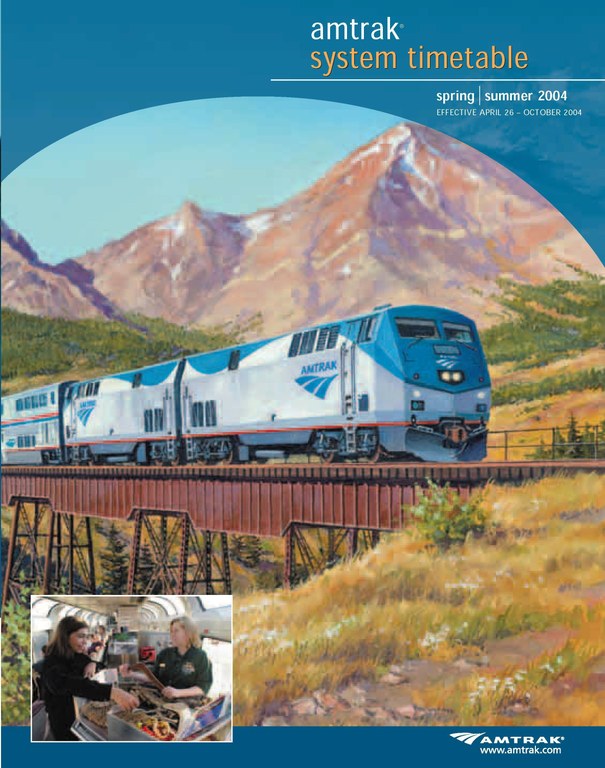 On June 11, 2004, the famed Empire Builder (Chicago-Seattle/Portland) celebrated 75 years of vital cross-country service. The train originally operated between Chicago and St. Paul, Minn., over the Chicago, Burlington, and Quincy Railroad, and then westward to Seattle over the tracks of the Great Northern Railway, with the Portland section utilizing the Spokane, Portland & Seattle Railway west of Spokane, Wash. On the morning of June 11, 1929, the new train was christened the Empire Builder before a west-bound departure from St. Paul Union Depot. The premier service was named for James J. Hill, the founder of what became the GN. Amtrak took over the service on May 1, 1971, and it recently resumed serving St. Paul’s newly restored Union Depot.
On June 11, 2004, the famed Empire Builder (Chicago-Seattle/Portland) celebrated 75 years of vital cross-country service. The train originally operated between Chicago and St. Paul, Minn., over the Chicago, Burlington, and Quincy Railroad, and then westward to Seattle over the tracks of the Great Northern Railway, with the Portland section utilizing the Spokane, Portland & Seattle Railway west of Spokane, Wash. On the morning of June 11, 1929, the new train was christened the Empire Builder before a west-bound departure from St. Paul Union Depot. The premier service was named for James J. Hill, the founder of what became the GN. Amtrak took over the service on May 1, 1971, and it recently resumed serving St. Paul’s newly restored Union Depot.
75th Anniversary celebrations occurred aboard trains traveling in both directions and at many key stations. The spring/summer national system timetable featured a reproduction of an oil-on-canvas painting by noted railroad artist J. Craig Thorpe, whose artwork has graced Amtrak calendars and other promotional items. This piece commissioned by Charles Mott, entitled Companion of the Rockies, depicts the eastbound Empire Builder crossing soaring Two Medicine Trestle near Glacier National Park in western Montana.
In addition to the train’s anniversary, 2004 also marked the 200th anniversary of the Lewis and Clark Expedition. The accompanying photo on the cover shows a volunteer from the Trails & Rails program, a partnership between Amtrak and the National Park Service. From April through September, program volunteers aboard trains invite travelers to learn about the cultural heritage and natural resources along the route.
November 8, 2010
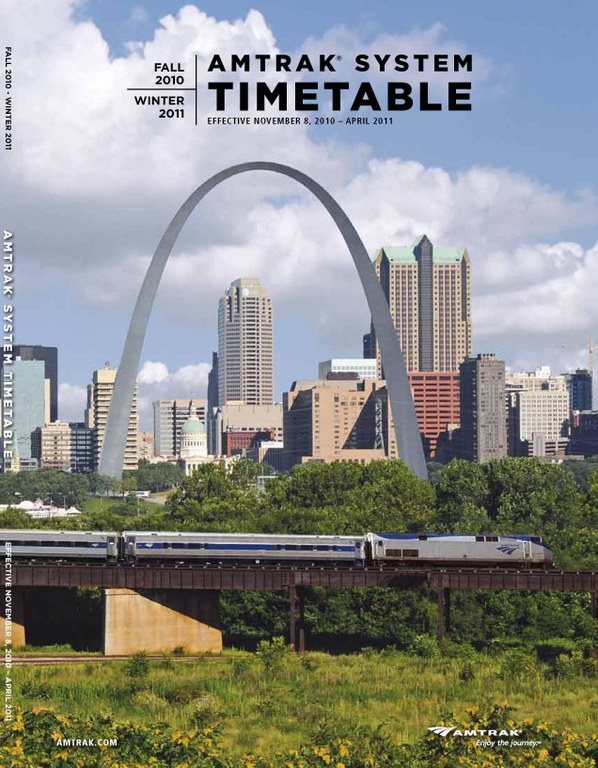 A train set against the Gateway Arch – the symbolic entry to the western United States – was a fitting image for a national timetable. Four national network trains provide cross-country journeys through the West, connecting communities large and small and offering breathtaking views of North America’s majestic landscapes.
A train set against the Gateway Arch – the symbolic entry to the western United States – was a fitting image for a national timetable. Four national network trains provide cross-country journeys through the West, connecting communities large and small and offering breathtaking views of North America’s majestic landscapes.
The Empire Builder (Chicago-Seattle/Portland) crosses the country’s northern tier, giving views of the Mississippi River, Montana’s Big Sky country and the Columbia River Gorge. Travelers take in the Rocky Mountains and snow-capped Sierra Nevadas from the California Zephyr (Chicago-Emeryville), while the Southwest Chief (Chicago-Los Angeles) provides a journey through the desert landscapes of New Mexico and Arizona. Along the country’s southern tier, the Sunset Limited (New Orleans-Los Angeles) passes through Louisiana bayous, southwestern deserts and California mountains.
This photograph shows a Lincoln Service train departing St. Louis for Chicago. In 2006, the state of Illinois partnered with Amtrak to inaugurate eight new trains serving downstate communities. The Illinois Department of Transportation has also received Federal Railroad Administration High Speed and Intercity Passenger Rail grant program funds for several projects to advance the goal of bringing more frequencies, reduced trip times, more reliable operations and new service on Amtrak routes in the state. $1.2 billion was allocated to improve the Chicago-St. Louis rail corridor so passenger trains will be able to attain regular speeds of 110 mph.
Do you have a favorite national system timetable cover? Share it with us in the comments section below.
Amtrak national timetable cover images courtesy of The Museum of Railway Timetables
1 John F. Stover, American Railroads (Chicago: University of Chicago Press, 1997), 205.
2 Dick Clover and Tom Coval (Revised by A.B. Magary), The Wonderful World Of Railroad Timetables (1979).
3 Ibid.
4 Ibid.
5 The Southern Railway would turn over its Southern Crescent (New York-Atlanta-New Orleans) to Amtrak in 1979, when it was renamed the Crescent. The Denver & Rio Grande Western discontinued its Rio Grande Zephyr (Denver-Salt Lake City) in 1983, and Amtrak subsequently rerouted the San Francisco Zephyr (Chicago-Oakland (San Francisco)) over Rio Grande tracks. To mark the reroute, the train was renamed the California Zephyr.




